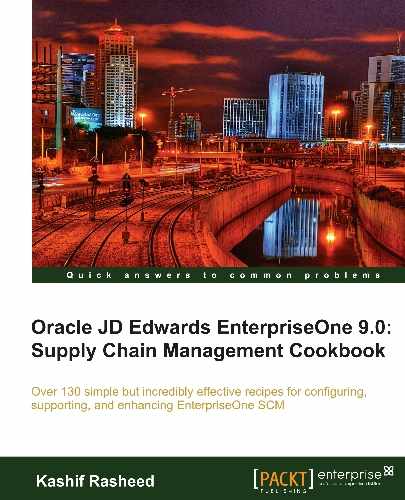A Tag Count is a location-based method of counting inventory. This recipe provides the details of tag counts and discusses how to:
- Select the items for the count program
- Print inventory tags
- Set processing options for printing inventory tags (R41607)
- Record tag distribution and receipt information
- Set processing options for the tag status review (P41604)
- Enter the tag count results
- Review tag status summaries
- Review tag count variances
- Run tag count updates
Before you start the tag count process, you must run the select items for Count-Tag Inventory (R416060) batch application. The select items for the Count-Tag Inventory batch application builds a record for each inventory item to be counted, and records the current on-hand quantity and cost for each item.
- Go to (G41) Inventory Management | Periodic Processing | Inventory Count Alternatives.
- Run the print inventory tags program (R41607) to print inventory tags for each location. In the Processing option of the Tag program, enter the number of tags that you want to print, and enter the branch plant information. Record the tag number for tag updates.
- Enter the tag count result, which you recorded during the physical inventory count.
- Review the tag status summaries to verify that you don't have a quantity variance.
- Compare the online on-hand count to the physical count in the Tag Variance Review form.
- Review the tag count variances as sown in the following example. Variances can be in quantity or amount. If the difference occurs in quantity, it's called a Quantity Variance and if the difference occurs in amount, it's called a Amount Variance.

- After you have entered the tag count results and reviewed any variances, run the tag inventory update program. Select Inventory Count Alternatives (G4121) and choose Tag Update.
- On the Tag Update application, enter the tag number on the data selection where F4160= tag number, which you have already created. Note the following screenshot:

- Enter the General Ledger date in the relevant processing option, and run the batch application R41610 to update the new quantity information in the Item Location record and Item Ledger.

Review the tag status after running the Tag Update application. The Tag Status Description should show as Closed.

- Journal entries are created automatically based on the AAI's setup. The Document Type created is PI and the Batch Type is N.

A tag count is a method of counting all items in a location. When you perform a Tag Count, you physically tag and count all items twice by location. Typically, a tag count occurs at the end of the year or any other frequency scheduled by a company. To complete a tag count, two teams independently perform the same physical inventory and record their data on two different parts of the tag. Later, you use each team's data to compare the results and resolve any variances.
Consider using a tag count in conjunction with a cycle count to ensure accuracy. You also can use the following programs to indicate that a counted quantity is on certain existing license plates. You can access the LPN Detail Entry Program (P46L42) from the Row menu on the Cycle Count Entry form or from the Form menu on the Tag Count Entry form.
Although you can print tags at any time, you typically print tags at the beginning of the tag count process, and distribute them to the teams who are counting items. Run the Print Inventory Tags (R41607) batch application to print inventory tags for each location. The tag is a two-part form that includes branch/plant, date printed, and tag number.
You can vary the tag's format to accommodate for your individual business needs. The system stores the tag number and tag status in the F4160 table.
